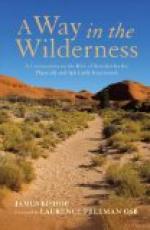I know one such place, and visited it twice from my summer camp. It is in a dark tamarack swamp by a lonely lake at the head of the Little-South-West Miramichi River, in New Brunswick. I found it one summer when trying to force my way from the big lake to a smaller one, where trout were plenty. In the midst of the swamp I stumbled upon a pair of caribou skeletons, which surprised me; for there were no hunters within a hundred miles, and at that time the lake had lain for many years unvisited. I thought of fights between bucks, and bull moose, how two bulls will sometimes lock horns in a rush, and are too weakened to break the lock, and so die together of exhaustion. Caribou are more peaceable; they rarely fight that way; and, besides, the horns here were not locked together, but lying well apart. As I searched about, looking for the explanation of things, thinking of wolves, yet wondering why the bones were not gnawed, I found another skeleton, much older, then four or five more; some quite fresh, others crumbling into mould. Bits of old bone and some splendid antlers were scattered here and there through the underbrush; and when I scraped away the dead leaves and moss, there were older bones and fragments mouldering beneath.
I scarcely understood the meaning of it at the time; but since then I have met men, Indians and hunters, who have spent much time in the wilderness, who speak of “bone yards” which they have discovered, places where they can go at any time and be sure of finding a good set of caribou antlers. And they say that the caribou go there to die.
All animals, when feeble with age, or sickly, or wounded, have the habit of going away deep into the loneliest coverts, and there lying down where the leaves shall presently cover them. So that one rarely finds a dead bird or animal in the woods where thousands die yearly. Even your dog, that was born and lived by your house, often disappears when you thought him too feeble to walk. Death calls him gently; the old wolf stirs deep within him, and he goes away where the master he served will never find him. And so with your cat, which is only skin-deep a domestic animal; and so with your canary, which in death alone would be free, and beats his failing wings against the cage in which he lived so long content. But these all go away singly, each to his own place. The caribou is the only animal I know that remembers, when his separation comes, the ties which bound him to the herd winter after winter, through sun and storm, in the forest where all was peace and plenty, and on the lonely barrens where the gray wolf howled on his track; so that he turns with his last strength from the herd he is leaving to the greater herd which has gone before him—still following his leaders, remembering his first lesson to the end.
Sometimes I have wondered whether this also were taught in the caribou school; whether once in his life Megaleep were led to the spot and made to pass through it, so that he should feel its meaning and remember. That is not likely; for the one thing which an animal cannot understand is death. And there were no signs of living caribou anywhere near the place that I discovered; though down at the other end of the lake their tracks were everywhere.




